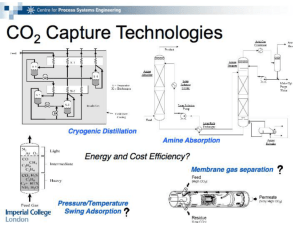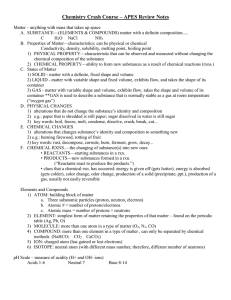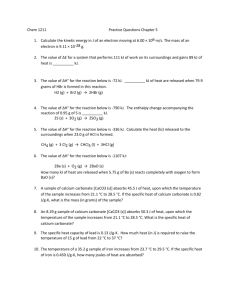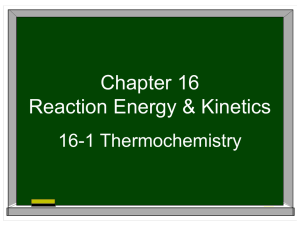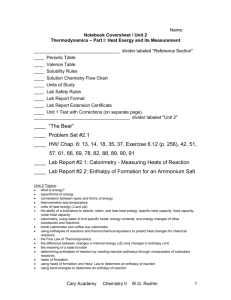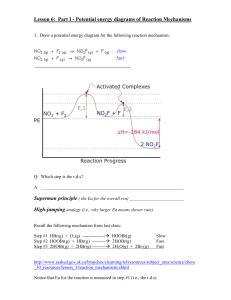PowerPoint - Dr. Samples' Chemistry Classes
advertisement
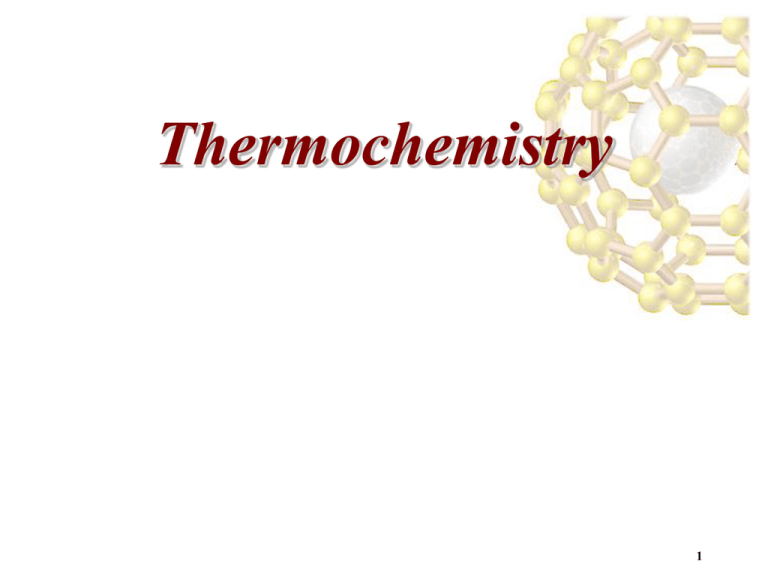
Thermochemistry 1 Energy • Thermochemistry is the study of energy changes and exchanges in chemical systems. • Energy is basically the ability of a system to supply heat or to perform work. • You already know the 2 principal classes of energy. – Kinetic – Potential 2 Kinetic Energy • Kinetic Energy, the energy of motion. • When atoms or molecules move, their mass and speed give them energy: 3 Potential Energy • Potential Energy, internal or stored energy. • It may be stored because of position, or it may be stored internally in chemical substances. • A ball or boulder on a hill has potential energy because of its position in space: if it gets pushed, it will roll down the hill, converting potential energy into kinetic energy (and other energies). 4 Chemical Energy • Chemical Energy is actually both potential and kinetic energy. • It is the energy a chemical substance has based on the positions and motions of its atoms and electrons. • When a chemical rxn takes place, new chemical substances are produced which have different energies as they have different positions and motions of electrons, etc. 5 Conservation of Energy & the First Law • You learned the Law of Conservation of Energy, which is also called the First Law of Thermodynamics: • Energy can’t be created nor destroyed; it can only be converted from one form of energy to another and transferred from one object to another. 6 Conservation of Energy & the First Law • To follow energy changes, we have defined a system and the surroundings. • The contents of a rxn vessel constitute the system. • Everything else is the surroundings. • Note: if a rxn takes place in a solvent, like water, then the solvent is usually classified as part of the surroundings. 7 Conservation of Energy & the First Law • The surroundings either supply energy to the system or absorb energy released by the system. (and of course we can state the same for the system) • This means that the energy change for the system equals the negative of the energy change of the surroundings: • As we are following the rxn (system), when we say energy or E, we typically mean the Esys 8 The First Law of Thermodynamics • The first law is stated in 2 ways: – The energy of the Universe is constant. – The energy of an isolated system (there is NO energy transfer with any surroundings) is constant. • So there is no free lunch in the Universe! • If someone tries to sell you a product that makes energy out of nothing, don’t buy it! 9 Units of Energy • Scientists use the energy unit joule, J. • The J is an abbreviated unit, here’s the units that you would get from the above equation: KE = (kg)(m2)/s2 • We still use the old unit calorie, cal, where: 1 cal = 4.184J (exact) • If you look at your food label and it says 140 Cal, this is a food calorie, Cal, where 1 Cal = 1000 cal. • The typical male is supposed to eat 2000 Cal/day. How many J is this? 10 Internal Energy • The internal energy of a chemical system is the sum of all of the kinetic and potential energies of all of the particles in the system. E = KE + PE • As stated earlier, it is the ability to produce heat and work. 11 Internal Energy • Unfortunately, it is basically impossible to measure the actual internal energy of a system. • What we can measure is the change in energy of a system as it undergoes a chemical rxn. E = Heat + Work = q + w • If the system is open to atmospheric pressure (as many rxns are), then q is called qp • If the system is closed and has a constant volume, then q is called qv • We will typically do problems which are at constant pressure, so qp is used. 12 Internal Energy • Work in a chemical system is: w = -PV • The negative sign reflects the standard terminology that work produced is a negative quantity. • For work produced, the volume increases so V is positive. 13 Internal Energy • Work produced by a chemical system is typically small so the following assumption is made: • Although this is an approximation, it is generally (but not always) within 1%. 14 Energy and Enthalpy • Chemists also have defined another energy term, enthalpy, H, or the enthalpy change, H. H is the heat energy change, or the enthalpy change of a constant pressure system. • So H = qp H is also just called q • You will use both terms! 15 Enthalpy and H • Enthalpy, H, and H are state functions as are E and E. • What does this mean? – State functions are independent of path, or how the system arrives at its final state. – What’s another state function that you know? 16 Enthalpy and H • We can find the change in enthalpy, H, for a chemical reaction or for a chemical process: 17 Enthalpy and H • If H is positive, then heat energy was absorbed by the system. This is an endothermic process or rxn. • If H is negative, then heat energy was released by the system. This is an exothermic process or rxn. • Since we want to find H for a rxn or process, we need to know the individual H values for all the products and reactants. (more on this later) 18 Meaning of H • Let’s look at a rxn: • Look at the ways we can show H. • What does this H value mean? • As the units are kJ/mol rxn, it is a conversion factor, which can take us between mol of a reactant or product and heat energy required or released! • What if we write the reverse reaction? 19 Stoichiometry and H • For the above rxn, 2043 kJ of heat energy is released for every mol of propane which is burned. • So how much heat energy would be released if 3.5 moles of propane were burned? • How much heat energy would be released if 25.0 g of carbon dioxide was produced? 20 Calorimetry and Enthalpy Changes • One common experimental method to find the q or H for a rxn is to conduct the rxn inside a calorimeter. • Calorimeters may be constant pressure or constant volume. • In the lab, you will use a “coffee cup” calorimeter, which is constant pressure. • Another common type is a “bomb” calorimeter, which is constant volume. 21 22 23 Calorimetry and Enthalpy Changes • Whatever type of calorimeter is used, the temperature change of the system, or the surrounding water reservoir, is measured. • This gives us T, where T = Tf - Ti • But how can we get from T to H? 24 Calorimetry and Enthalpy Changes • A property called the heat capacity of a chemical (or a mixture) lets us make this conversion. • Heat capacity is a measure of a substance’s (or a mixture’s) ability to store heat. • The higher the heat capacity of an object, the more heat energy it can store without its temperature changing. 25 Calorimetry and Enthalpy Changes • We have tables of heat capacities, given in 2 forms: – Specific Heat Capacity, s or cp, which is defined as the amount of heat necessary to raise exactly 1 g of a substance by exactly 1°C. The units are J/g•°C. – Molar Heat Capacity, C or Cm, which is the amount of heat necessary to raise exactly 1 mol of a substance by exactly 1°C. The units are J/mol•°C. 26 27 Calorimetry and Enthalpy Changes • So the heat capacity, the amount of a substance and the T for a rxn can let us calculate the H for a rxn, Hrxn • What kind of substances have high heat capacities? • Water has one of the highest heat capacities, much higher than most common substances. It’s specific heat capacity is 4.184 J/g•°C. • Water can store a lot of heat energy, and this is crucial for life on our planet. • As our planet is a liquid water-based planet, water is a heat sink or heat reservoir. • So our oceans and large lakes moderate temperature fluctuations on our planet, keeping it from getting too hot during the day and too cold at night. 28 Calorimetry and Enthalpy Changes •Here’s the equations and some problems! 29 Hess’s Law: Adding Rxns Together • If we want to find the H for a rxn, and we have H values for other rxns, sometimes we can use Hess’s Law to calculate the desired H from the given H values. • Hess’s Law: the overall enthalpy change is equal to the sum of the individual rxns which make up the rxn. • For example, what if we want to find the Hrxn for the following rxn? 30 Hess’s Law: Adding Rxns Together • Can you see how to manipulate Rxn 2) and 3) in order to get Rxn 1)? • Do you add them, add the reverse of one, multiply or divide them by some whole number, etc? • In this case, addition of Rxn 2) and 2 times Rxn 3) gives you Rxn 1) • So what’s the Hrxn for Rxn 1)? It’s the sum of the Hrxn for Rxn 2) and 2 x 3). 31 Standard Heats of Formation and Hrxn •Earlier, you learned the following: H°rxn = H°products - H°reactants •This means that we need to know the H values for all of the reactants and products in order to calculate Hrxn •Where can we find these values? 32 Standard Heats of Formation and Hrxn • There are Tables and Books of Tables which list the thermodynamic values for H for thousands of compounds. • To avoid confusion, these values are listed as Hf°, or the Standard State Enthalpy Changes. • What’s Standard State? – Standard State is defined as 1 atm pressure (now it’s 1 bar); 1 M for all solutions; and at a specified temperature, which is usually 25°C. 33 Standard Heats of Formation, H°f • But what do these H°f values mean? • They are the standard heats of formation for a substance. • They are the enthalpy change when exactly 1 mol of the substance is made from its elements under standard state conditions. • We can write equations which show exactly what we mean. 34 H° Tables 35 Standard Heats of Formation, H°f • How would you make propane, C3H8, from the elements? • You make it from the most stable elemental form of the element. • Here’s the heat of formation equation for propane: • Note that graphite is the stable elemental form of carbon. 36 Standard Heats of Formation, H°f • What’s the heat of formation equation for liquid water? • Note in the above that we are ALLOWED (actually we are MANDATED) to have fractions in the rxn equation! • Why? Because of the definition of a H°f : exactly 1 mol of the substance is made! 37 Standard Heats of Formation, H°f • Now we can use H°rxn = H°products - H°reactants • There really is a more mathematically correct way to write this equation: 38 Standard Heats of Formation, H°f • So we just look up the H°f for all of the products and reactants and add and subtract them together. • Example: Using Tables of H°f values, find the H°rxn for the combustion of propane: • What is interesting is that the H°f for the stable elemental state of an element is 0. • In problems, you will not usually be given the H°f value for stable elemental forms, you are expected to know that it is zero! (Remember this!) 39 Heat of Combustion, H°comb • You noticed that in Heat of Formation equations, you could legally have fractions in the rxn equation. • There is another common case where it is legal to have fractions in the rxn equation: Heat of Combustion Rxn Equations. • The Heat of Combustion, H°comb (or just H°c) is defined is the heat energy change when exactly 1 mol of a substance is combusted with oxygen gas. • We are allowed to have fractions in combustion rxn equations if we are calculating heats of combustion. 40 Heat of Combustion, H°comb • Write the combustion rxn equation for benzene, C6H6, and calculate its H°comb. • Of course, combustions rxns are very important to us as they heat our homes, power our cars, and light our homes (as most electricity is produced by burning fossil fuels). • We can use H°comb values for the reactants and products in a chemical reaction to find H°rxn • However, as combustion is for breaking apart a compound, while heats of formation were for making a compound, we have to change the signs of the H°comb values before we use them in products - reactants. 41 42 Enthalpy Changes for Phase Changes • There are 6 changes of state that a chemical may undergo: – – – – – – Vaporization Condensation Sublimation Melting or Fusing Freezing Deposition 43 Enthalpy Changes for Phase Changes • There is a H associated with all of these phase changes. Hvap is the enthalpy change associated with the vaporization process or the heat of vaporization; Hf is the heat of fusion; and Hsub is the heat of sublimation. • As condensation if the reverse of vaporization, we don’t have a special term for the heat of condensation, it’s just –Hvap • 3 of the phase changes are exothermic: which? 44 Enthalpy Changes for Phase Changes • We can also combine 2 phase changes! • When we sublime something, it goes from the solid state to the gas state directly. • But as H is independent of path (it’s a State Function), we could first melt the solid and then vaporize it to the gas. The H value for the 2 paths would be the same, so long as the temperature was held constant. • So for constant T, Hsub = Hvap + Hf 45 46
